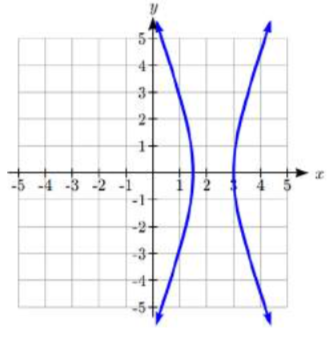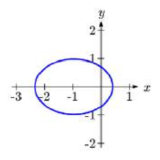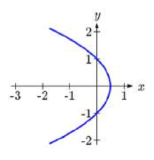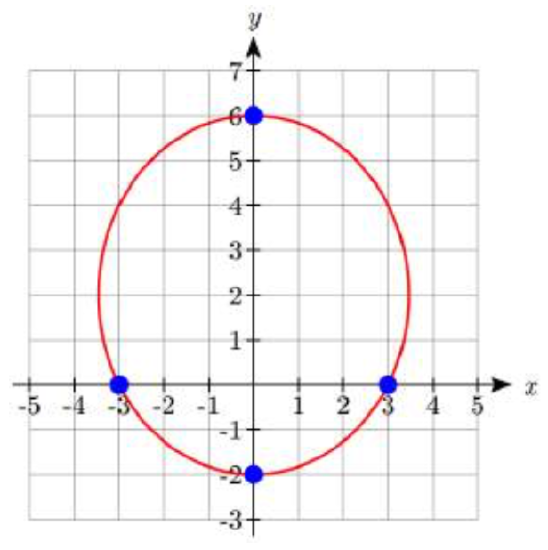9.4: Conics in Polar Coordinates
- Page ID
- 13885
In the preceding sections, we defined each conic in a different way, but each involved the distance between a point on the curve and the focus. In the previous section, the parabola was defined using the focus and a line called the directrix. It turns out that all conic sections (circles, ellipses, hyperbolas, and parabolas) can be defined using a single relationship.
CONIC SECTIONS GENERAL Definition
A conic section can be defined by placing a fixed point at the origin, \(F\left( 0,0 \right)\), called the focus, and drawing a line L called the directrix at \(x = \pm p\) or \(y = \pm p\). The conic section is the set of all points \(Q\left( x,y \right)\) for which the ratio of the distance from \(Q\) to \(F\) to the distance from \(Q\) to the directrix is some positive constant \(e\), called the eccentricity. In other words, \[\dfrac{d\left( Q,F \right)}{d(Q,L)} = e\]

Warning: the eccentricity, \(e\), is not the Euler constant \(e \approx 2.71828\) we studied with exponentials
The Polar Form of a Conic
To create a general equation for a conic section using the definition above, we will use polar coordinates. Represent \(Q\left( x,y \right)\) in polar coordinates so \(\left( x,y \right) = \left( r\cos (\theta ), r\sin (\theta ) \right)\). For now, we’ll focus on the case of a horizontal directrix at \(y = - p\), as in the picture above on the left.
The distance from the focus to the point \(Q\) in polar is just \(r\).
The distance from the point \(Q\) to the directrix \(y = - p\) is\(r\sin (\theta ) - ( - p) = p + r\sin (\theta )\)
The ratio of these should be the constant eccentricity e, so
\[\dfrac{d\left( Q,F \right)}{d(Q,L)} = e\nonumber\]Substituting in the expressions for the distances,
\[\dfrac{r}{p + r\sin (\theta )} = e\nonumber\]
To have a standard polar equation, we need to solve for r. Start by clearing the fraction.
\[r = e\left( {p + r\sin (\theta )} \right)\nonumber\]Distribute
\[r = ep + er\sin (\theta )\nonumber\]Move terms with \(r\) to the left
\[r - er\sin (\theta ) = ep\nonumber\]Factor the \(r\)
\[r\left( 1 - e\sin (\theta ) \right) = ep\nonumber\]Divide
\[r = \dfrac{ep}{1 - e\sin (\theta )}\nonumber\]
We could repeat the same approach for a directrix at \(y = p\) and for vertical directrices to obtain the polar equations below.
POLAR EQUATION FOR A CONIC SECTION
A conic section with a focus at the origin, eccentricity \(e\), and directrix at \(x = \pm p\) or \(y = \pm p\) will have polar equation:
\[r = \dfrac{ep}{1 \pm e\sin (\theta )}\text{ when the directrix is }y = \pm p\]
\[r = \dfrac{ep}{1 \pm e\cos (\theta )}\text{ when the directrix is }x = \pm p\]
Example \(\PageIndex{1}\)
Write the polar equation for a conic section with eccentricity 3 and directrix at \(x = 2\).
Solution
We are given \(e = 3\) and \(p = 2\). Since the directrix is vertical and at a pos itive \(x\) value, we use the equation involving cos with the positive sign.
itive \(x\) value, we use the equation involving cos with the positive sign.
\[r = \dfrac{(3)(2)}{1 + 3\cos (\theta )} = \dfrac{6}{1 + 3\cos (\theta )}\nonumber\]
Graphing that using technology reveals it’s an equation for a hyperbola.
Exercise \(\PageIndex{1}\)
Write a polar equation for a conic with eccentricity 1 and directrix at \(y = - 3\).
- Answer
-
\[r = \dfrac{(1)(3)}{1 - \sin(\theta)}\quad r = \dfrac{3}{1 - \sin (\theta)}\nonumber\]
Relating the Polar Equation to the Shape
It was probably not obvious to you that the polar equation in the last example would give the graph of a hyperbola. To explore the relationship between the polar equation and the shape, we will try to convert the polar equation into a Cartesian one. For simplicity, we will consider the case where the directrix is \(x = 1\).
\[r = \dfrac{e}{1 + e\cos (\theta )}\nonumber\]Multiply by the denominator
\[r\left( 1 + e\cos (\theta ) \right) = e\nonumber\]Rewrite \(\cos (\theta ) = \dfrac{x}{r}\)
\[r\left( 1 + e\dfrac{x}{r} \right) = e\nonumber\]Distribute
\[r + ex = e\nonumber\]Isolate \(r\)
\[r = e - ex\nonumber\]Square both sides
\[r^2 = \left( e - ex \right)^2\nonumber\]Rewrite \(r^2 = x^2 + y^2\) and expand
\[x^2 + y^2 = e^2 - 2e^2x + e^2x^2\nonumber\]Move variable terms to the left
\[x^2 + 2e^2x - e^2x^2 + y^2 = e^2\nonumber\]Combine like terms
\[x^2(1 - e^2) + 2e^2x + y^2 = e^2\nonumber\]
We could continue, by completing the square with the \(x\) terms, to eventually rewrite this in the standard form as \(\left(\frac{(1-e^{2})^{2}}{e^{2}} \right)\left(x-\frac{e^{2}}{1-e^{2}} \right)^{2}+\left(\frac{1-e^{2}}{e^{2}} \right)y^{2}=1\), but happily there’s no need for us to do that.
In the equation \(x^2(1 - e^2) + 2e^2x + y^2 = e^2\), we can see that:
When \(e < 1\), the coefficients of both \(x^2\) and \(y^2\) are positive, resulting in ellipse.
When \(e > 1\), the coefficient of \(x^2\) is negative while the coefficient of \(y^2\) is positive, resulting in a hyperbola.
When \(e = 1\), the \(x^2\) will drop out of the equation, resulting in a parabola.
RELATION BETWEEN THE POLAR EQUATION OF A CONIC AND ITS SHAPE
For a conic section with a focus at the origin, eccentricity \(e\), and directrix at \(x = \pm p\) or \(y = \pm p\),
when \(0 < e < 1\), the graph is an ellipse
when \(e = 1\), the graph is a parabola
when \(e > 1\), the graph is a hyperbola
Taking a more intuitive approach, notice that if \(e < 1\), the denominator \(1 + e\cos (\theta )\) will always be positive and so \(r\) will always be positive. This means that the radial distance \(r\) is defined and finite for every value of \(\theta\), including \(\dfrac{\pi }{2}\), with no breaks. The only conic with this characteristic is an ellipse.
\(1 + e\cos (\theta )\) will always be positive and so \(r\) will always be positive. This means that the radial distance \(r\) is defined and finite for every value of \(\theta\), including \(\dfrac{\pi }{2}\), with no breaks. The only conic with this characteristic is an ellipse.
If \(e = 1\), the denominator will be positive for all values of \(\theta\), except \( - \pi \) where the denominator is 0 and \(r\) is undefined. This fits  with a parabola, which has a point at every angle except at the angle pointing along the axis of symmetry away from the vertex.
with a parabola, which has a point at every angle except at the angle pointing along the axis of symmetry away from the vertex.
If \(e > 1\), then the denominator will be zero at two angles other than \( \pm \dfrac{\pi }{2}\), and \(r\) will be negative for a set  of \(\theta\) values. This division of positive and negative radius values would result in two distinct branches of the graph, fitting with a hyperbola.
of \(\theta\) values. This division of positive and negative radius values would result in two distinct branches of the graph, fitting with a hyperbola.
Example \(\PageIndex{2}\)
For each of the following conics with focus at the origin, identify the shape, the directrix, and the eccentricity.
a. \(r = \dfrac{8}{1 - 2\sin (\theta )}\)
b. \(r = \dfrac{6}{3 - 2\cos (\theta )}\)
c. \(r = \dfrac{8}{5 + 5\sin (\theta )}\)
Solution
a. This equation is already in standard form \(r = \dfrac{ep}{1 \pm e\sin (\theta )}\) for a conic with horizontal directrix at \(y = - p\).
The eccentricity is the coefficient of \(\sin (\theta )\), so \(e = 2\).
Since \(e = 2 > 1\), the shape will be a hyperbola.
Looking at the numerator, \(ep = 8\), and substituting \(e = 2\) gives \(p = 4\). The directrix is \(y = - 4\).
b. This equation is not in standard form, since the constant in the denominator is not 1. To put it into standard form, we can multiply the numerator and denominator by 1/3.
\[r = \dfrac{6}{3 - 2\cos (\theta )} \cdot \dfrac{\dfrac{1}{3}}{\dfrac{1}{3}} = \dfrac{6\left( \dfrac{1}{3} \right)}{\left( 3 - 2\cos (\theta ) \right)\left( \dfrac{1}{3} \right)} = \dfrac{2}{1 - \dfrac{2}{3}\cos (\theta )}\nonumber\]
This is the standard form for a conic with vertical directrix \(x = - p\). The eccentricity is the coefficient on \(\cos (\theta )\), so \(e = \dfrac{2}{3}\).
Since \(0 < e < 1\), the shape is an ellipse.
Looking at the numerator, \(ep = 2\), so \(\dfrac{2}{3}p = 2\), giving \(p = 3\). The directrix is \(x = - 3\).
c. This equation is also not in standard form. Multiplying the numerator and denominator by 1/5 will put it in standard form.
\[r = \dfrac{8}{5 + 5\sin (\theta )} \cdot \dfrac{\dfrac{1}{5}}{\dfrac{1}{5}} = \dfrac{8\left( \dfrac{1}{5} \right)}{\left( 5 + 5\sin (\theta ) \right)\left( \dfrac{1}{5} \right)} = \dfrac{\dfrac{8}{5}}{1 + \sin (\theta )}\nonumber\]
This is the standard form for a conic with horizontal directrix at \(y = p\).
The eccentricity is the coefficient on \(\sin (\theta )\), so \(e = 1\). The shape will be a parabola.
Looking at the numerator, \(ep = \dfrac{8}{5}\). Since \(e = 1\), \(p = \dfrac{8}{5}\). The directrix is \(y = \dfrac{8}{5}\).
Notice that since the directrix is above the focus at the origin, the parabola will open downward.
Exercise \(\PageIndex{2}\)
Identify the shape, the directrix, and the eccentricity of \(r = \dfrac{9}{4 + 2\cos (\theta )}\)
- Answer
-
We can convert to standard form by multiplying the top and bottom by \(\dfrac{1}{4}\).
\[r = \dfrac{\dfrac{9}{4}}{1 + \dfrac{1}{2}\cos (\theta )}\nonumber\]Eccentricity = \(\dfrac{1}{2}\), so the shape is an ellipse.
The numerator is \[ep = \dfrac{1}{2}p = \dfrac{9}{4}\nonumber\]The directrix is \[x = \dfrac{9}{2}\nonumber\]
Graphing Conics from the Polar Form
Identifying additional features of a conic in polar form can be challenging, which makes graphing without technology likewise challenging. We can utilize our understanding of the conic shapes from earlier sections to aid us.
Example \(\PageIndex{3}\)
Sketch a graph of \(r = \dfrac{3}{1 - 0.5\sin (\theta )}\) and write its Cartesian equation.
Solution
This is in standard form, and we can identify that \(e = 0.5\), so the shape is an ellipse.
From the numerator, \(ep = 3\), so \(0.5p = 3\), giving p = 6. The directrix is \(y = - 6\).
To sketch a graph, we can start by evaluating the function at a few convenient ? values, and finding the corresponding Cartesian coordinates.
\[\theta = 0\quad r = \dfrac{3}{1 - 0.5\sin (0)} = \dfrac{3}{1} = 3\quad (x,y) = (3,0)\nonumber\]
\[\theta = \dfrac{\pi }{2}\quad r = \dfrac{3}{1 - 0.5\sin \left( \dfrac{\pi }{2} \right)} = \dfrac{3}{1 - 0.5} = 6\quad (x,y) = (0,6)\nonumber\]
\[\theta = \pi \quad r = \dfrac{3}{1 - 0.5\sin (\pi )} = \dfrac{3}{1} = 3\quad (x,y) = ( - 3,0)\nonumber\]
\[\theta = \dfrac{3\pi }{2}\quad r = \dfrac{3}{1 - 0.5\sin \left( \dfrac{3\pi }{2} \right)} = \dfrac{3}{1 + 0.5} = 2\quad (x,y) = (0, - 2)\nonumber\]
Plotting these points and remembering the origin is one of the foci gives an idea of the shape, which we could sketch in. To get a b etter understanding of the shape, we could use these features to find more.
etter understanding of the shape, we could use these features to find more.
The vertices are at (0, -2) and (0, 6), so the center must be halfway between, at \(\left( 0,\dfrac{ - 2 + 6}{2} \right)\) = (0, 2). Since the vertices are a distance a from the center, \(a = 6 – 2 = 4\).
One focus is at (0, 0), a distance of 2 from the center, so \(c = 2\), and the other focus must be 2 above the center, at (0, 4).
We can now solve for b: \(b^2 = a^2 - c^2\), so \(b^2 = 4^2 - 2^2 = 10\), hence \(b = \pm \sqrt {10} \). The minor axis endpoints would be at \(\left( - \sqrt {10} ,2 \right)\) and \(\left( \sqrt {10} ,2 \right)\).
We can now use the center, \(a\), and \(b\) to write the Cartesian equation for this curve:
\[\dfrac{x^2}{10} + \dfrac{(y - 2)^2}{16} = 1\nonumber\]
Exercise \(\PageIndex{3}\)
Sketch a graph of \(r = \dfrac{6}{1 + 2\cos (\theta )}\) and identify the important features.
- Answer
-
The eccentricity is \(e = 2\), so the graph of the equation is a hyperbola. The directrix is \(x = 3\). Since the directrix is a vertical line and the focus is at the origin, the hyperbola is horizontal.
\[\theta = 0\quad r = \dfrac{6}{1 + 2\cos (0)} = \dfrac{6}{1 + 2} = 2\quad (x,y) = (2,0)\nonumber\]
\[\theta = \dfrac{\pi }{2}\quad r = \dfrac{6}{1 + 2\cos \left( \dfrac{\pi }{2} \right)} = \dfrac{6}{1} = 6\quad (x,y) = (0,6)\nonumber\]
\[\theta = \pi \quad r = \dfrac{6}{1 + 2\cos (\pi )} = \dfrac{6}{1 - 2} = - 6\quad (x,y) = (6,0)\nonumber\]
\[\theta = \dfrac{3\pi }{2}\quad r = \dfrac{6}{1 + 2\cos \left( \dfrac{3\pi }{2} \right)} = \dfrac{6}{1} = 6\quad (x,y) = (0, - 6)\nonumber\]Plotting those points, we can connect the three on the left with a smooth curve to form one branch of the hyperbola, and th
 e other branch will be a mirror image passing through the last point.
e other branch will be a mirror image passing through the last point.The vertices are at (2, 0) and (6, 0).
The center of the hyperbola would be at the midpoint of the vertices, at (4, 0).
The vertices are a distance \(a = 2\) from the center.
The focus at the origin is a distance \(c = 4\) from the center.
Solving for \(b\), \(b^2 = 4^2 - 2^2 = 12\). \(b = \pm \sqrt {12} = \pm 2 \sqrt 3 \).The asymptotes would be \(y = \pm \sqrt 3 \left( x - 4 \right)\).
The Cartesian equation of the hyperbola would be:
\(\dfrac{\left( x - 4 \right)^2}{4} - \dfrac{y^2}{12} = 1\)
Important Topics of This Section
- Polar equations for Conic Sections
- Eccentricity and Directrix
- Determining the shape of a polar conic section


